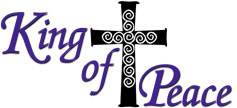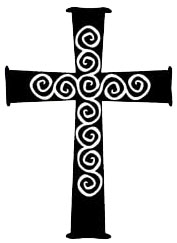|
The Rev. Frank
Logue
Two Paths—Glory and Service Glory. That’s what James and John see on the horizon. The brothers were disciples of Jesus who could see beyond their present reality of walking dust-covered roads on the edge of Jewish society to a day when Jesus as Messiah would be the new great king of Israel. Glory was coming for Jesus and if they played their cards right, glory could be coming for James and John as well. The only problem was that James and John still did not understanding that Jesus was proclaiming a world turned upside down. James and John were trying to make equal claim on being next in line to Jesus, while Jesus was all the while trying to get it through to the former fishermen, that it was the first who would be last and the last who would be first. In seeking glory, James and John were only asking to be humbled. James and John were, of course, not the subtlest of persons when it comes to the backstage political maneuverings for power. They just came out and asked for Jesus to do for them whatever they asked. Jesus made no promise, giving only the non-committal “What is it you want me to do for you?” Then the sons of Zebedee laid it all out, saying, “Grant us to sit, one at your right hand and one at your left, in your glory.” James and John are picturing something like a throne room in the New Israel with Jesus as King and each of them in an only slightly less jeweled throne, wearing an only slightly less ornate crown. Many probably shared their vision of the future. After all, the common expectation of the Messiah in Jesus’ own lifetime was that the Messiah would come and bring earthly political and military defeat to Israel’s enemies. To think of Jesus as the Messiah for many people meant to see him as the one to overthrow the Roman Empire and set up the Kingdom of God right there, right then. This was certainly the sort of idea James and John had in mind when they spoke of Jesus coming into his glory. The Bible presents a very different idea of Jesus’ coming into his glory. We do know when it happened and who was on his right and left when it occurred. Jesus came into his glory through his obedience unto death on the cross. Jesus came into his glory on a hill we know as Calvary. In Jesus’ own time, the hill on the outskirts of Jerusalem was known as Golgotha—the place of the skull. The main reason Rome used the site for public executions is that the rocky knoll was both outside of town and along the main road in so that all who came and went in Jerusalem would get the warning not to cross the Roman Empire. Jesus was neither the first to be crucified on that hilltop nor the last. In fact, there were two others put to death that morning Jesus was executed. We remember two thieves were the ones on Jesus’ right and left when he came into his glory. This was not the scene James and John pictured. In fact, it seems that what happened that Friday when Jesus came into his glory was not what anyone else on earth pictured. If Jesus’ death had not been prophesied by Jesus himself and other prophets writing hundreds of years earlier, I’m not sure we humans could ever have made sense out of it. Our reading from the Prophet Isaiah this morning is an important example of the prophesies that were in Israel’s sacred writings long before Jesus birth. Yet, by the time Jesus’ was born, no one was reading this passage from Isaiah as they looked forward to the Messiah. You would have been hard-pressed to find a Jew who did not know of the suffering servant passages in Isaiah, but they just didn’t see the Messiah in those texts. How could it be the Messiah? Isaiah prophesied of a person who would be unjustly killed and that in his death, this martyr would carry our infirmities and diseases, our transgressions and iniquities. A Jewish martyr, yes. The Messiah, no. In Jewish history, there were plenty of examples to cause them to expect a faithful Jew could be killed for no good reason. From Abel’s death at the hands of his jealous brother Cain, to the wholesale slaughter of faithful Jews in Israel by King Antiochus Epiphanes about 160 years before Jesus’ birth, there had been many good people put to death for no good reason. The perversion of justice prophesied by Isaiah seemed all too real. All of this gave meaning to the suffering servant passages, but none of this was tied up in speculation about the Messiah. And yet, a sacrificial death had been God’s plan all along. In the movie, Jesus of Nazareth, the director made a bold interpretive move in portraying of the crucifixion. The faithful Jewish leader Nicodemus recites the words from Isaiah 53 as Jesus dies. While we have no reason to think this scene actually happened, we have no reason to doubt that soon after the resurrection, many Jews were reinterpreting Isaiah 53 in the light of Easter. This is the cup Jesus had in mind when James and John approached their teacher about their places of honor in Jesus’ future glory. Jesus’ knew that that he would be crushed for our sins. Jesus knew that it was his bruises, his wounds that would heal us. Jesus was God made human and God would not give up on his love for us no matter what the cost. If being God in First Century Palestine meant that Rome would unjustly put him to death on a cross, then Jesus would pay that price. It was so beyond what anyone expected to happen to the Messiah that Isaiah wrote hundreds of years earlier, “Who could have imagined his future.” Even the one who predicted what would one day happen knew that no one would expect what was coming. Of course they did not expect it. Why did it have to happen? Why did Jesus have to die? Jesus told his disciples in our Gospel reading this morning what he thought his death would be about. Jesus said he was going to give his life as a ransom for many. Of course, the idea that the sacrifice of a life could be for the forgiveness sins was not a new one with Jesus. Judaism had centuries of practice in sacrificial culture. Goats, bulls, lambs, and even doves were among the many animals offered as a sin offering. The life of the animal was given as a sacrifice to atone for the sins of the people. The Jews had not themselves invented the idea of sacrifice. The Jews did put an end to the Canaanite ideas of human sacrifice that preceded them, but they did not abolish animal sacrifices. Moses’ law proscribed when and how animal sacrifices were to be offered, and it was in this culture of sacrifice that Jesus ministered. There had always been voices within that culture that spoke against sacrifices. In Psalm 50, the Psalmist wrote,
“If I were hungry I would not tell you,
Do you think I eat the flesh of bulls, The answer in a sacrificial culture, is, Yes, God we did think you wanted that blood, those lives. And while the Psalmist writes that the content of the heart is what matters, he does not write directly against sacrifice. And so it was within this culture that lifted up animal sacrifices as how one could get right with God after committing sin that Jesus came to do away with the whole sacrificial system. God ended the system of sacrifice by sacrificing himself, God the Son. Jesus’ death showed how far God was willing to go to reconcile all humanity to God's self. This is captured well in a prayer from our Book of Common Prayer, which says, “Lord Jesus Christ, you stretched out your arms of love on the hard wood of the cross that everyone might come within the reach of your saving embrace.”[1] Jesus’ death on the cross was a full and complete sacrifice through which God showed God's love for us. God’s sacrifice of Jesus ended the sacrificial system with a death that came once, for all. Jesus’ death revealed to humanity both the depth of our estrangement from God and the path back to reconciliation—which is faith in God as revealed in Jesus, the Christ. Jesus was the one who Isaiah had called the righteous one, who will make many righteous and bear their sins. This is why we can speak of Jesus’ death of being when he came into his glory. In the Garden of Gethsemene before his arrest, Jesus prayed, “Let this cup pass from me.” Then he prayed for God’s will rather than his own. For Jesus, drinking the cup meant partaking of all God had set for him to do. The cup was Jesus own life and he drank it to the full, fully offering all of himself back to God. When we partake of the cup of communion, we too share in his life. We drink of the cup so that the life of Jesus may flow into our lives. Yet, we do not drink of the cup for ourselves only. In the words of Eucharistic Prayer C, from our Book of Common Prayer, we pray, “Deliver us from the presumption of coming to this Table for solace only, and not for strength; for pardon only, and not for renewal. Let the grace of this Holy Communion make us one body, one spirit in Christ, that we may worthily serve the world in his name.” We take the cup of Christ so that we may be strengthened with that life giving presence of Jesus in us, not for us alone, but so that we can go out and serve others in Jesus’ name. We need to learn from James and John’s mistake. They saw their close connection to God the Son as a path to glory. Jesus assured the brothers following him meant the path to service. Once you give your life to Jesus, you, too, are not on the path to glory but the path to service. Jesus’ paid the price for your sins. He drank the cup to the fullest. He paid the debt you could not pay. The challenge then is not to earn God’s favor, or to pay God back as if that could happen. The challenge becomes to follow Jesus in a life directed not toward yourself, but toward others. It may sound kinda boring or just plain not fun, but following the path of service to others that God has set out for you is the most fulfilling, rewarding thing you can do with your life. Amen. [1] Collect for Mission on page 101 of the Book of Common Prayer. Nearly identical language also appears within the Eucharistic Prayer, on page 362.
| |

